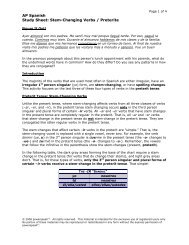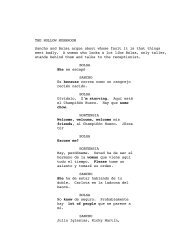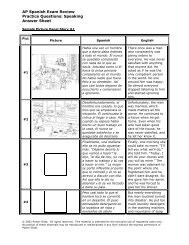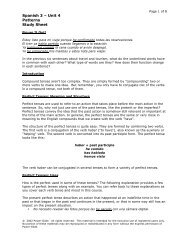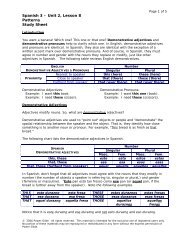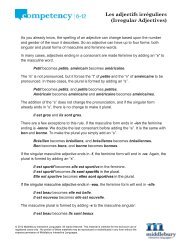Order of pronouns
Order of pronouns
Order of pronouns
Create successful ePaper yourself
Turn your PDF publications into a flip-book with our unique Google optimized e-Paper software.
<strong>Order</strong> <strong>of</strong> <strong>pronouns</strong><br />
You have already learned about different types <strong>of</strong> <strong>pronouns</strong>, including direct object <strong>pronouns</strong>, indirect<br />
object <strong>pronouns</strong>, the pronoun y, and the pronoun en. Let’s start by reviewing each pronoun and how<br />
it is used.<br />
A direct object pronoun replaces the direct object <strong>of</strong> the sentence. Here is a table summarizing the<br />
direct object <strong>pronouns</strong>.<br />
Singular me te le, la, l’<br />
Plural nous vous les<br />
Est-ce que Nicolas a oublié sa valise ? (Did Nicolas forget his suitcase?)<br />
Oui, il l’a oubliée. (Yes, he forgot it [feminine direct object = feminine agreement on past<br />
participle].)<br />
The indirect object pronoun replaces the indirect object <strong>of</strong> a sentence. The indirect object is always<br />
preceded by the preposition à + a person. Review each indirect object pronoun below.<br />
Singular me te lui<br />
Plural nous vous leur<br />
As-tu parlé aux enfants ? (Did you speak to the children?)<br />
Non, je ne leur ai pas parlé. (No, I did not speak to them.)<br />
The pronoun y is used for places introduced by any preposition besides de, and for things preceded<br />
by the preposition à.<br />
Comment vas-tu aller à la fête ce soir ? (How are you going to the party tonight?)<br />
Je vais y aller en voiture. (I’m going to go there by car.)<br />
The pronoun en is used for a place or thing preceded by the preposition de, or for a person or thing<br />
preceded by an indefinite article, a partitive article, or a number or expression <strong>of</strong> quantity.<br />
Voudriez-vous une part de gâteau ? (Would you like a piece <strong>of</strong> cake?)<br />
Ah oui, j’en voudrais bien une, merci. (Oh yeah, I would love to have one, thanks.)<br />
© 2011 Middlebury Interactive Languages. All rights reserved. This material is intended for the exclusive use <strong>of</strong> registered users only. No portion <strong>of</strong> these<br />
materials may be reproduced or redistributed in any form without the express permission <strong>of</strong> Middlebury Interactive Languages.
In French, it is not unusual to have several <strong>pronouns</strong> in a sentence. If that is the case, each pronoun<br />
follows a very specific order. The object direct <strong>pronouns</strong> will come first, followed by the indirect object<br />
pronoun, followed by y, and by en. Remember that every pronoun must be placed before the verb it<br />
is referring to. Here is a list <strong>of</strong> <strong>pronouns</strong> and their respective order. Note that you can’t use every<br />
single one <strong>of</strong> these <strong>pronouns</strong> together, but that this is a general list for the ordering <strong>of</strong> <strong>pronouns</strong> when<br />
you use a few <strong>of</strong> them together.<br />
Subject + (ne) +<br />
me<br />
te le lui<br />
se + la + leur<br />
nous<br />
vous<br />
les<br />
+ y + en + verb + (pas)<br />
Est-ce que tu as acheté les pommes au marché ? (Did you buy the apples at the market?)<br />
Oui, je les y ai acheté. (Yes, I bought them there.)<br />
Tu as donné de l’argent à la vendeuse ? (Did you give some money to the cashier?)<br />
Oui, je lui en ai donné. (Yes, I gave her some.)<br />
When using the imperative form, the order <strong>of</strong> <strong>pronouns</strong> will change, and the <strong>pronouns</strong> will be placed<br />
after the verb, in this manner:<br />
verb +<br />
le<br />
moi<br />
toi<br />
la<br />
les<br />
+<br />
lui<br />
nous<br />
vous<br />
leur<br />
Apportez la lettre à Monsieur Jean ! (Bring the letter to Monsieur Jean!)<br />
Apportez-la-lui ! (Bring it to him!)<br />
+ y + en<br />
Laissez les enfants chanter à la chorale ! (Let the children sing at the choir!)<br />
Laissez-les-y chanter ! (Let them sing there!)<br />
Notice that the order is still the same as in affirmative statements (direct object pronoun, followed by a<br />
indirect object pronoun, followed by y, and en) but the verb will come first. In the command form, me<br />
and te become moi and toi, and they become m’ and t’ if placed right before y or en.<br />
Tu veux des bonbons ? (Do you want some candy?)<br />
© 2011 Middlebury Interactive Languages. All rights reserved. This material is intended for the exclusive use <strong>of</strong> registered users only. No portion <strong>of</strong> these<br />
materials may be reproduced or redistributed in any form without the express permission <strong>of</strong> Middlebury Interactive Languages.
Oui, donne m’en ! (Yes, give me some!)<br />
When the command is negative, then the order <strong>of</strong> <strong>pronouns</strong> will be the same as in affirmative<br />
statements.<br />
Ne dis pas à Pierre d’aller à Paris. (Do not tell Pierre to go to Paris.)<br />
Ne lui dis pas d’y aller. (Do not tell him to go there.)<br />
Remember to practice <strong>pronouns</strong> so you can avoid repetitions.<br />
© 2011 Middlebury Interactive Languages. All rights reserved. This material is intended for the exclusive use <strong>of</strong> registered users only. No portion <strong>of</strong> these<br />
materials may be reproduced or redistributed in any form without the express permission <strong>of</strong> Middlebury Interactive Languages.




